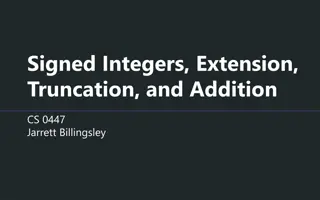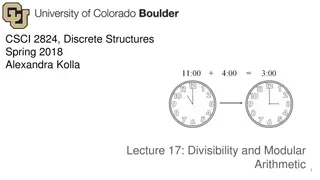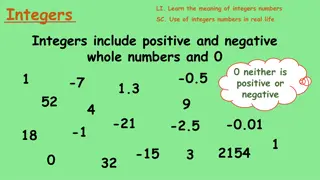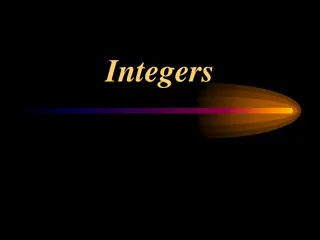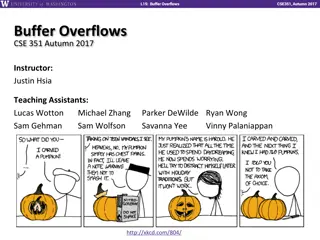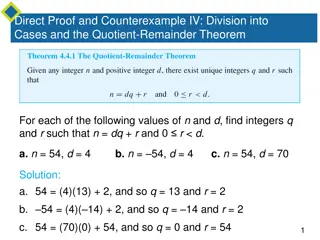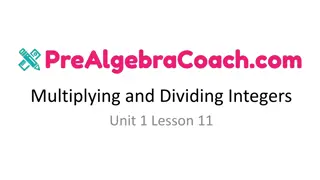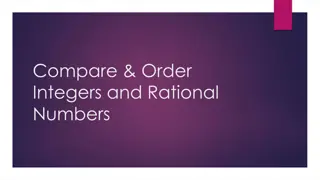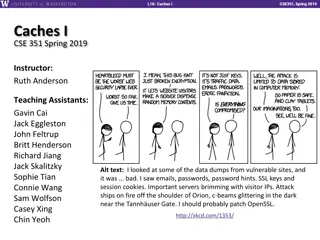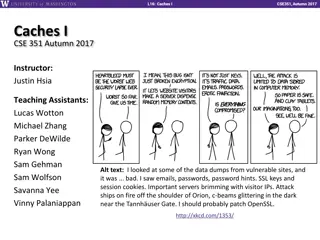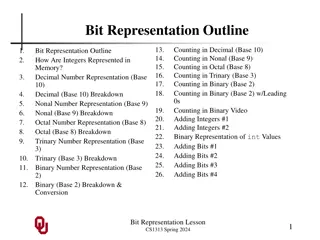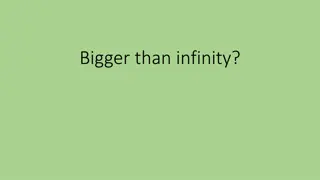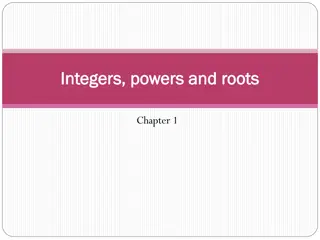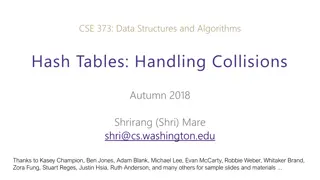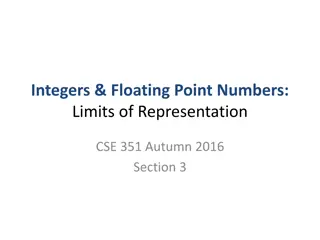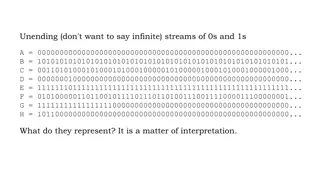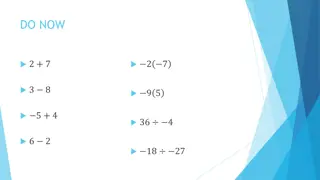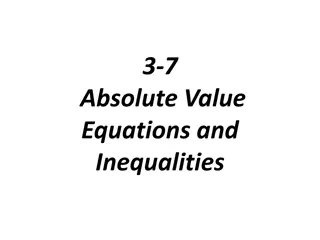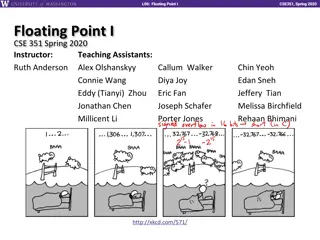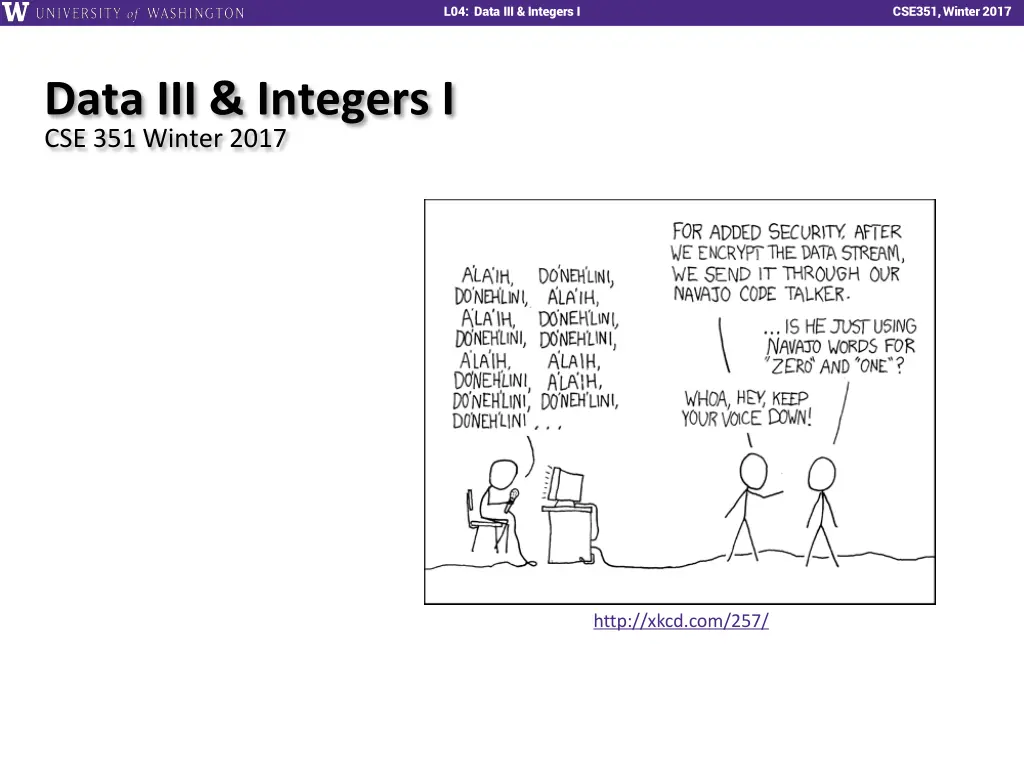
Examining Data Representations and Combinational Logic Introduction
Explore data representations and combinatorial logic concepts in this informative content. Learn about examining data representations, byte representation of data, casting data types to byte arrays, and more. Dive into the fundamentals of data interpretation and logic in computer science.
Download Presentation

Please find below an Image/Link to download the presentation.
The content on the website is provided AS IS for your information and personal use only. It may not be sold, licensed, or shared on other websites without obtaining consent from the author. If you encounter any issues during the download, it is possible that the publisher has removed the file from their server.
You are allowed to download the files provided on this website for personal or commercial use, subject to the condition that they are used lawfully. All files are the property of their respective owners.
The content on the website is provided AS IS for your information and personal use only. It may not be sold, licensed, or shared on other websites without obtaining consent from the author.
E N D
Presentation Transcript
L01: Intro, Combinational Logic L01: Introduction L04: Data III & Integers I CSE369, Autumn 2016 CSE351, Autumn 2016 CSE351, Winter 2017 Data III & Integers I CSE 351 Winter 2017 http://xkcd.com/257/
L01: Intro, Combinational Logic L01: Introduction L04: Data III & Integers I CSE369, Autumn 2016 CSE351, Autumn 2016 CSE351, Winter 2017 Administrivia Thanks for all feedback and bug reports Keep using the anonymous feedback My office hours now Mon 11-noon. Lab1 --- fun! 2
L01: Intro, Combinational Logic L01: Introduction L04: Data III & Integers I CSE369, Autumn 2016 CSE351, Autumn 2016 CSE351, Winter 2017 Examining Data Representations Code to print byte representation of data void show_bytes(char* start, int len) { int i; for (i = 0; i < len; i++) printf("%p\t0x%.2x\n", start+i, *(start+i)); printf("\n"); } printf directives: %p Print pointer \t Tab %x Print value as hex \n New line 3
L01: Intro, Combinational Logic L01: Introduction L04: Data III & Integers I CSE369, Autumn 2016 CSE351, Autumn 2016 CSE351, Winter 2017 Examining Data Representations Code to print byte representation of data Any data type can be treated as a byte array by casting it to char C has unchecked casts !! DANGER !! void show_bytes(char* start, int len) { int i; for (i = 0; i < len; i++) printf("%p\t0x%.2x\n", start+i, *(start+i)); printf("\n"); } void show_int(int x) { show_bytes( (char *) &x, sizeof(int)); } 4
L01: Intro, Combinational Logic L01: Introduction L04: Data III & Integers I CSE369, Autumn 2016 CSE351, Autumn 2016 CSE351, Winter 2017 show_bytes Execution Example int a = 12345; // 0x00003039 printf("int a = 12345;\n"); show_int(a); // show_bytes((char *) &a, sizeof(int)); Result (Linux x86-64): Note: The addresses will change on each run (try it!), but fall in same general range int a = 12345; 0x7fffb7f71dbc 0x7fffb7f71dbd 0x7fffb7f71dbe 0x7fffb7f71dbf 0x39 0x30 0x00 0x00 5
L01: Intro, Combinational Logic L01: Introduction L04: Data III & Integers I CSE369, Autumn 2016 CSE351, Autumn 2016 CSE351, Winter 2017 Memory, Data, and Addressing Representing information as bits and bytes Organizing and addressing data in memory Manipulating data in memory using C Boolean algebra and bit-level manipulations 6
L01: Intro, Combinational Logic L01: Introduction L04: Data III & Integers I CSE369, Autumn 2016 CSE351, Autumn 2016 CSE351, Winter 2017 Boolean Algebra Developed by George Boole in 19th Century Algebraic representation of logic (True 1, False 0) AND: A&B=1 when both A is 1 and B is 1 OR: A|B=1 when either A is 1 or B is 1 XOR: A^B=1 when either A is 1 or B is 1, but not both NOT: ~A=1 when A is 0 and vice-versa DeMorgan s Law: ~(A|B) = ~A & ~B ~(A&B) = ~A | ~B AND OR XOR NOT & 0 1 | 0 1 ^ 0 1 ~ 0 0 0 0 0 1 0 0 1 0 1 1 0 1 1 1 1 1 1 0 1 0 7
L01: Intro, Combinational Logic L01: Introduction L04: Data III & Integers I CSE369, Autumn 2016 CSE351, Autumn 2016 CSE351, Winter 2017 General Boolean Algebras Operate on bit vectors Operations applied bitwise All of the properties of Boolean algebra apply 01101001 & 01010101 01101001 | 01010101 01101001 ^ 01010101 ~ 01010101 Examples of useful operations: ? ^? = 0 ? | 1 = 1 01010101 ^ 01010101 01010101 | 11110000 How does this relate to set operations? 8
L01: Intro, Combinational Logic L01: Introduction L04: Data III & Integers I CSE369, Autumn 2016 CSE351, Autumn 2016 CSE351, Winter 2017 Representing & Manipulating Sets Representation A ?-bit vector represents subsets of {0, , ? 1} aj = 1 iff j A 01101001 76543210 { 0, 3, 5, 6 } 01010101 76543210 { 0, 2, 4, 6 } Operations & | ^ ~ 01000001{ 0, 6 } 01111101{ 0, 2, 3, 4, 5, 6 } Intersection Union Symmetric difference 00111100{ 2, 3, 4, 5 } Complement 10101010{ 1, 3, 5, 7 } 10
L01: Intro, Combinational Logic L01: Introduction L04: Data III & Integers I CSE369, Autumn 2016 CSE351, Autumn 2016 CSE351, Winter 2017 Bit-Level Operations in C & (AND), | (OR), ^ (XOR), ~ (NOT) View arguments as bit vectors, apply operations bitwise Apply to any integral data type long, int, short, char, unsigned Examples with char a, b, c; a = (char) 0x41; b = ~a; a = (char) 0x69; b = (char) 0x55; c = a & b; a = (char) 0x41; b = a; c = a ^ b; // 0x41->0b 0100 0001 // 0b 1011 1110->0xBE // 0x69->0b 0110 1001 // 0x55->0b 0101 0101 // 0b 0100 0001->0x41 // 0x41->0b 0100 0001 // 0b 0100 0001 // 0b 0000 0000->0x00 11
L01: Intro, Combinational Logic L01: Introduction L04: Data III & Integers I CSE369, Autumn 2016 CSE351, Autumn 2016 CSE351, Winter 2017 Contrast: Logic Operations Logical operators in C: && (AND), || (OR), ! (NOT) 0 is False, anything nonzero is True Always return 0 or 1 Early termination (a.k.a. short-circuit evaluation) of &&, || Examples (char data type) !0x41 -> 0x00 !0x00 -> 0x01 !!0x41 -> 0x01 p && *p++ 0xCC && 0x33 -> 0x01 0x00 || 0x33 -> 0x01 Avoids null pointer (0x0) access via early termination Short for: if (p) { *p++; } 12
L01: Intro, Combinational Logic L01: Introduction L04: Data III & Integers I CSE369, Autumn 2016 CSE351, Autumn 2016 CSE351, Winter 2017 Memory & data Integers & floats Machine code & C x86 assembly Procedures & stacks Arrays & structs Memory & caches Processes Virtual memory Memory allocation Java vs. C Roadmap C: Java: Car c = new Car(); c.setMiles(100); c.setGals(17); float mpg = c.getMPG(); car *c = malloc(sizeof(car)); c->miles = 100; c->gals = 17; float mpg = get_mpg(c); free(c); Assembly language: get_mpg: pushq %rbp movq %rsp, %rbp ... popq %rbp ret OS: Machine code: 0111010000011000 100011010000010000000010 1000100111000010 110000011111101000011111 Computer system: 13
L01: Intro, Combinational Logic L01: Introduction L04: Data III & Integers I CSE369, Autumn 2016 CSE351, Autumn 2016 CSE351, Winter 2017 But before we get to integers . Encode a standard deck of playing cards 52 cards in 4 suits How do we encode suits, face cards? What operations do we want to make easy to implement? Which is the higher value card? Are they the same suit? 14
L01: Intro, Combinational Logic L01: Introduction L04: Data III & Integers I CSE369, Autumn 2016 CSE351, Autumn 2016 CSE351, Winter 2017 Two possible representations 1) 1 bit per card (52): bit corresponding to card set to 1 low-order 52 bits of 64-bit word One-hot encoding (similar to set notation) Drawbacks: Hard to compare values and suits Large number of bits required 2) 1 bit per suit (4), 1 bit per number (13): 2 bits set 13 numbers Pair of one-hot encoded values Easier to compare suits and values, but still lots of bits used 4 suits Can we do better? 15
L01: Intro, Combinational Logic L01: Introduction L04: Data III & Integers I CSE369, Autumn 2016 CSE351, Autumn 2016 CSE351, Winter 2017 Two better representations 3) Binary encoding of all 52 cards only 6 bits needed 26= 64 52 low-order 6 bits of a byte Fits in one byte (smaller than one-hot encodings) How can we make value and suit comparisons easier? 4) Separate binary encodings of suit (2 bits) and value (4 bits) value suit 00 01 10 11 Also fits in one byte, and easy to do comparisons K Q J . . . ... 3 2 A 1101 1100 1011 0011 0010 0001 16
L01: Intro, Combinational Logic L01: Introduction L04: Data III & Integers I CSE369, Autumn 2016 CSE351, Autumn 2016 CSE351, Winter 2017 mask: a bit vector designed to achieve a desired behavior when used with a bitwise operator on another bit vector v. Here we turns all but the bits of interest in v to 0. Compare Card Suits char hand[5]; // represents a 5-card hand char card1, card2; // two cards to compare card1 = hand[0]; card2 = hand[1]; ... if ( sameSuitP(card1, card2) ) { ... } #define SUIT_MASK 0x30 int sameSuitP(char card1, char card2) { return (!((card1 & SUIT_MASK) ^ (card2 & SUIT_MASK))); //return (card1 & SUIT_MASK) == (card2 & SUIT_MASK); } returns int equivalent SUIT_MASK = 0x30 = 0 0 1 1 0 0 0 0 value suit 17
L01: Intro, Combinational Logic L01: Introduction L04: Data III & Integers I CSE369, Autumn 2016 CSE351, Autumn 2016 CSE351, Winter 2017 mask: a bit vector designed to achieve a desired behavior when used with a bitwise operator on another bit vector v. Here we turns all but the bits of interest in v to 0. Compare Card Suits #define SUIT_MASK 0x30 int sameSuitP(char card1, char card2) { return (!((card1 & SUIT_MASK) ^ (card2 & SUIT_MASK))); //return (card1 & SUIT_MASK) == (card2 & SUIT_MASK); } ? ? & 0 0 0 1 0 0 1 0 0 0 0 1 1 1 0 1 & SUIT_MASK 0 0 1 1 0 0 0 0 = 0 0 1 1 0 0 0 0 = 0 0 0 1 0 0 0 0 0 0 0 1 0 0 0 0 ^ 0 0 0 0 0 0 0 0 ! !(x^y) equivalent to x==y 0 0 0 0 0 0 0 1 18
L01: Intro, Combinational Logic L01: Introduction L04: Data III & Integers I CSE369, Autumn 2016 CSE351, Autumn 2016 CSE351, Winter 2017 mask: a bit vector designed to achieve a desired behavior when used with a bitwise operator on another bit vector v. Compare Card Values char hand[5]; // represents a 5-card hand char card1, card2; // two cards to compare card1 = hand[0]; card2 = hand[1]; ... if ( greaterValue(card1, card2) ) { ... } #define VALUE_MASK 0x0F int greaterValue(char card1, char card2) { return ((unsigned int)(card1 & VALUE_MASK) > (unsigned int)(card2 & VALUE_MASK)); } VALUE_MASK = 0x0F = 0 0 0 0 1 1 1 1 value suit 19
L01: Intro, Combinational Logic L01: Introduction L04: Data III & Integers I CSE369, Autumn 2016 CSE351, Autumn 2016 CSE351, Winter 2017 mask: a bit vector designed to achieve a desired behavior when used with a bitwise operator on another bit vector v. Compare Card Values #define VALUE_MASK 0x0F int greaterValue(char card1, char card2) { return ((unsigned int)(card1 & VALUE_MASK) > (unsigned int)(card2 & VALUE_MASK)); } 0 0 1 0 0 0 1 0? 0 0 0 0 1 1 1 1 VALUE_MASK = ? 0 0 1 0 1 1 0 1 & & 0 0 0 0 1 1 1 1 = 0 0 0 0 0 0 1 0 0 0 0 0 1 1 0 1 210>1310 0 (false) 20
L01: Intro, Combinational Logic L01: Introduction L04: Data III & Integers I CSE369, Autumn 2016 CSE351, Autumn 2016 CSE351, Winter 2017 Integers Representation of integers: unsigned and signed Integers in C and casting Sign extension Shifting and arithmetic 21
L01: Intro, Combinational Logic L01: Introduction L04: Data III & Integers I CSE369, Autumn 2016 CSE351, Autumn 2016 CSE351, Winter 2017 Encoding Integers The hardware (and C) supports two flavors of integers unsigned only the non-negatives signed both negatives and non-negatives Cannot represent all integers with ? bits Only 2? distinct bit patterns Unsigned values: Signed values: 2? 1 2? 1 1 0 ... 2? 1 Example: 8-bit integers (i.e., char) - + 128 ?? ? 0 ? +128 +?? ? +256 +?? 22
L01: Intro, Combinational Logic L01: Introduction L04: Data III & Integers I CSE369, Autumn 2016 CSE351, Autumn 2016 CSE351, Winter 2017 Unsigned Integers Unsigned values follow the standard base 2 system b7b6b5b4b3b2b1b0= b727+ b626+ + b121+ b020 Add and subtract using the normal carry and borrow rules, just in binary 63 + 8 00111111 +00001000 Useful formula: 2N 1 + 2N 2 + 4 + 2 + 1 = 2N 1 i.e., N1 s in a row = 2N 1 How would you make signed integers? 24
L01: Intro, Combinational Logic L01: Introduction L04: Data III & Integers I CSE369, Autumn 2016 CSE351, Autumn 2016 CSE351, Winter 2017 Sign and Magnitude Most Significant Bit Designate the high-order bit (MSB) as the sign bit sign=0: positive numbers; sign=1: negative numbers Positives: Using MSB as sign bit matches positive numbers with unsigned All zeros encoding is still = 0 Examples (8 bits): 0x00 = 000000002 is non-negative, because the sign bit is 0 0x7F = 011111112 is non-negative (+12710) 0x85 = 100001012 is negative (-510) 0x80 = 100000002 is negative... ... zero??? 25
L01: Intro, Combinational Logic L01: Introduction L04: Data III & Integers I CSE369, Autumn 2016 CSE351, Autumn 2016 CSE351, Winter 2017 Sign and Magnitude MSB is the sign bit, rest of the bits are magnitude Drawbacks? 7 + 0 15 0 6 + 1 14 1 1111 0000 1111 0000 1110 0001 1110 0001 5 + 2 13 2 1101 0010 1101 0010 4 + 3 12 3 1100 0011 1100 0011 Sign and Magnitude Unsigned 1011 0100 1011 0100 3 + 4 11 4 1010 0101 1010 0101 2 + 5 10 5 1001 0110 1001 0110 1000 0111 1000 0111 1 + 6 9 6 0 + 7 8 7 26
L01: Intro, Combinational Logic L01: Introduction L04: Data III & Integers I CSE369, Autumn 2016 CSE351, Autumn 2016 CSE351, Winter 2017 Sign and Magnitude MSB is the sign bit, rest of the bits are magnitude Drawbacks: Two representations of 0 (bad for checking equality) 7 + 0 6 + 1 1111 0000 1110 0001 5 + 2 1101 0010 4 + 3 1100 0011 Sign and Magnitude 1011 0100 3 + 4 1010 0101 2 + 5 1001 0110 1000 0111 1 + 6 0 + 7 27
L01: Intro, Combinational Logic L01: Introduction L04: Data III & Integers I CSE369, Autumn 2016 CSE351, Autumn 2016 CSE351, Winter 2017 Sign and Magnitude MSB is the sign bit, rest of the bits are magnitude Drawbacks: Two representations of 0 (bad for checking equality) Arithmetic is cumbersome Example: 4-3 != 4+(-3) 7 + 0 6 + 1 1111 0000 1110 0001 5 + 2 1101 0010 4 0100 - 0011 0001 4 0100 + 1011 1111 4 + 3 - 3 1 + -3 -7 1100 0011 Sign and Magnitude 1011 0100 3 + 4 1010 0101 Negatives increment in wrong direction! 2 + 5 1001 0110 1000 0111 1 + 6 0 + 7 28
L01: Intro, Combinational Logic L01: Introduction L04: Data III & Integers I CSE369, Autumn 2016 CSE351, Autumn 2016 CSE351, Winter 2017 Two s Complement Let s fix these problems: 1) Flip negative encodings so incrementing works 7 + 0 0 + 0 6 + 1 1 + 1 1111 0000 1111 0000 1110 0001 1110 0001 5 + 2 2 + 2 1101 0010 1101 0010 4 + 3 3 + 3 1100 0011 1100 0011 Sign and Magnitude Two s Complement 1011 0100 1011 0100 3 + 4 4 + 4 1010 0101 1010 0101 2 + 5 5 + 5 1001 0110 1001 0110 1000 0111 1000 0111 1 + 6 6 + 6 0 + 7 7 + 7 29
L01: Intro, Combinational Logic L01: Introduction L04: Data III & Integers I CSE369, Autumn 2016 CSE351, Autumn 2016 CSE351, Winter 2017 Two s Complement Let s fix these problems: 1) Flip negative encodings so incrementing works 2) Shift negative numbers to eliminate 0 1 + 0 2 + 1 1111 0000 MSB still indicates sign! 1110 0001 3 + 2 1101 0010 4 + 3 1100 0011 1011 0100 5 + 4 1010 0101 6 + 5 1001 0110 1000 0111 7 + 6 8 + 7 30
L01: Intro, Combinational Logic L01: Introduction L04: Data III & Integers I CSE369, Autumn 2016 CSE351, Autumn 2016 CSE351, Winter 2017 Two s Complement Negatives Accomplished with one neat mathematical trick! bw 1 has weight 2w 1, other bits have usual weights +2i bw-1 bw-2 . . . b0 4-bit Examples: 1 + 0 2 + 1 10102 unsigned: 1*23+0*22+1*21+0*20 = 10 1111 0000 1110 0001 3 + 2 1101 0010 10102two s complement: -1*23+0*22+1*21+0*20 = 6 4 + 3 1100 0011 Two s Complement -1 represented as: 11112 = -23+(23 1) MSB makes it super negative, add up all the other bits to get back up to -1 1011 0100 5 + 4 1010 0101 6 + 5 1001 0110 1000 0111 7 + 6 8 + 7 31
L01: Intro, Combinational Logic L01: Introduction L04: Data III & Integers I CSE369, Autumn 2016 CSE351, Autumn 2016 CSE351, Winter 2017 Why Two s Complement is So Great Roughly same number of (+) and ( ) numbers Positive number encodings match unsigned Single zero All zeros encoding = 0 1 + 0 2 + 1 1111 0000 1110 0001 3 + 2 Simple negation procedure: Get negative representation of any integer by taking bitwise complement and then adding one! ( ~x + 1 == -x ) 1101 0010 4 + 3 1100 0011 Two s Complement 1011 0100 5 + 4 1010 0101 6 + 5 1001 0110 1000 0111 7 + 6 8 + 7 32
L01: Intro, Combinational Logic L01: Introduction L04: Data III & Integers I CSE369, Autumn 2016 CSE351, Autumn 2016 CSE351, Winter 2017 Summary Bit-level operators allow for fine-grained manipulations of data Bitwise AND (&), OR (|), and NOT (~) different than logical AND (&&), OR (||), and NOT (!) Especially useful with bit masks Choice of encoding scheme is important Tradeoffs based on size requirements and desired operations Integers represented using unsigned and two s complement representations Limited by fixed bit width We ll examine arithmetic operations next lecture 33

